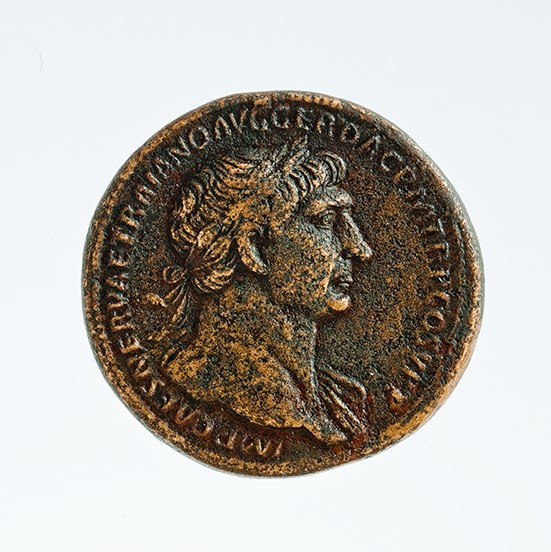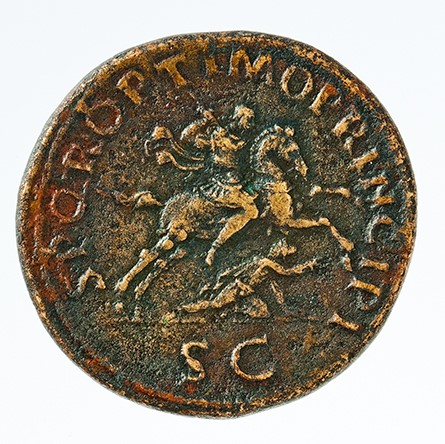Acquisition number: 1980.06
Obv.: Bust of Trajan, r., laureate, with slight drapery. IMP(eratori) CAES(ari) NERVAE TRAIANO AVG(usto) GER(manico) DAC(ico) P(ontifici) M(aximo) TR(ibunicia) P(otestate) CO(n)S(uli) V P(atri) P(atriae)
Rev.: Emperor on horseback, r., spearing Dacian below horse. S(enatus) P(opulus)Q(ue) R(omanus) OPTIMO PRINCIPI. In exergue, S(enatus) C(onsulto)
Title: Sestertius of Trajan - 1980.06
Acquisition number: 1980.06
Author or editor: Beryl Rawson
Culture or period: Roman Imperial
Date: AD 107
Material: Metal - Brass
Object type: Coins - Roman
Dimensions: 33mm (w)
Origin region or location: Italy
Origin city: Rome
Display case or on loan: 7
Keywords: Coin, sestertius, Roman, Imperial, Trajan
Sear, D.R., Roman Coins and their Values 5 vols (London, Spink, 2000-2014) 3205; Mattingly, H.,Coins of the Roman Empire in the British Museum, 6 vols (London, 1965) 841 (pl. 31.5).
1980.06
Sestertius of Trajan
23.51 g. AD 107
Obv.: Bust of Trajan, r., laureate, with slight drapery. IMP(eratori) CAES(ari) NERVAE TRAIANO AVG(usto) GER(manico) DAC(ico) P(ontifici) M(aximo) TR(ibunicia) P(otestate) CO(n)S(uli) V P(atri) P(atriae)
Rev.: Emperor on horseback, r., spearing Dacian below horse. S(enatus) P(opulus)Q(ue) R(omanus) OPTIMO PRINCIPI. In exergue, S(enatus) C(onsulto)
From Nerva through most of the second century the succession was arranged by adoption, as emperors had no natural son until Marcus Aurelius’ son Commodus (b. AD 161). Trajan’s nomenclature therefore incorporates the name of his predecessor Nerva. It also commemorates Trajan’s military victories: in Germany AD 98-99, and against the Dacians in two campaigns AD 101-102 and 105-6. It was after the first Dacian campaign that he received the title Dacicus. Trajan’s fifth consulship lasted from AD 104 to 111, which helps to date this coin.
The reverse type is similar to a scene on Trajan’s Column, which commemorated the Dacian Wars and was dedicated in AD 113.
Sear, D.R., Roman Coins and their Values 5 vols (London, Spink, 2000-2014) 3205; Mattingly, H.,Coins of the Roman Empire in the British Museum, 6 vols (London, 1965) 841 (pl. 31.5).

